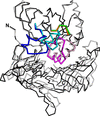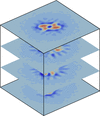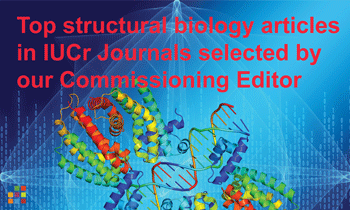issue contents
July 2024 issue

Cover illustration: The N-terminal domain of the backbone pilin LrpA in Ligilactobacillus ruminis [Prajapati et al. (2024), Acta Cryst. D80, 474]. Some Gram-positive bacteria frequently use sortase-dependent pili on their cell surfaces to facilitate cellular attachment, host colonization and biofilm formation. X-ray crystallography and SAXS have been used to determine linear and bent conformations of the backbone pilin LrpA from the gut-dwelling L. ruminis. The hinge region connecting the flexible N-terminal domain to the other two domains lets LrpA be assembled into dynamic pili via a new closure-and-twist motion, enabling these surface structures to reach host receptor sites and withstand shear forces during intestinal colonization.
research papers
A comparative analysis of the known crystal structures of the archaeal translation initiation factor 2 from Sulfolobus solfataricus and its individual subunits is reported. This work confirms the leading role of switch 1 in the function of the γ subunit of translation initiation factor 2 and reveals some important new details of this process.
Linear and bent conformations of the backbone pilin LrpA from the gut-dwelling Ligilactobacillus ruminis have been determined by X-ray crystallography and SAXS. The hinge region connecting the flexible N-terminal domain to the other two domains lets LrpA be assembled into dynamic pili via a new closure-and-twist motion, enabling these surface structures to reach host receptor sites and withstand shear forces during intestinal colonization.
Open  access
access
 access
accessA novel validation tool for transmission electron-microscopy maps utilizing independent small-angle X-ray scattering measurements is introduced and implemented. The power of this technique was demonstrated by testing it using simulated data and using it on real experimental data from online repositories.
The crystallographic structures of asparaginases of class 1 (bacterial-type), class 2 (plant-type) and class 3 (Rhizobium etli-type) in the PDB are reviewed in order to identify and, if possible, correct any modeling errors, with the purpose of creating a reliable data set for further research, including the development of new antileukemic agents.
Open  access
access
 access
accessElectron-density map segmentation into protein and solvent regions using deep neural networks improves density modification in X-ray structure solution from experimental phases.
Open  access
access
 access
accessPreferred orientation of macromolecules is one of the major issues that are commonly encountered in obtaining isotropic cryo-EM maps. Here, a comprehensive examination was performed of how macromolecule orientations respond to changes in physical factors, such as freezing temperature, and chemical factors, such as the addition of surfactants, for a standard set of macromolecules, which provides insights into their behaviour on grids and can be utilized to address the preferred orientation problem in a systemic manner for any given macromolecule.
EMDB references: CRP pentamer with CTAB, EMD-37864; CRP decamer with CTAB, EMD-37865; PaaZ with CTAB at 4°C, EMD-37866; catalase with SLS, EMD-37952; spike with CTAB, EMD-37953; catalase at 20°C, EMD-37954; catalase at 4°C, EMD-37955; catalase with CTAB, EMD-37956; β-galactosidase, no tag, EMD-39808; β-galactosidase, with tag, EMD-39809
Open  access
access
 access
accessA set of hydrogen bonds which occur in proteins between the Cδ1—H donor group of the tryptophan indole and main-chain carbonyl O atoms separated by 1–4 peptide units were characterized. These interactions stabilize unique and functionally important structural motifs and noncanonical side-chain conformations of tryptophan.

 journal menu
journal menu

























